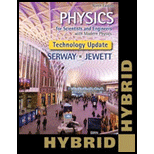
Concept explainers
(a)
The sound which arrives first.
(a)
Answer to Problem 66AP
The sound through the metal arrives first.
Explanation of Solution
When a hammer is used at one end, the sound can travel through both metal rod and air. The speed of the wave through metal rod is
Since, speed of the sound in metal is greater than the sped of the sound in air, the sound through metal arrives first.
Conclusion:
Therefore, the sound through the metal arrives first.
(b)
The length of the rod as a function of
(b)
Answer to Problem 66AP
The length of the rod as a function of
Explanation of Solution
Write the expression for the time taken by the sound to travel.
Here,
The delay between the arrival of pulses through copper and air is.
Here,
Rearrange equation (II) to obtain an expression for
Conclusion:
Substitute,
Therefore, length of the rod as a function of
(c)
The length of the rod if
(c)
Answer to Problem 66AP
The length of the rod if
Explanation of Solution
Write the expression for the length of the rod.
Conclusion:
Substitute,
Therefore, the length of the rod if
(d)
The length of the rod in terms of
(d)
Answer to Problem 66AP
The length of the rod in terms of
Explanation of Solution
The speed of the sound in rod is given as
Substitute,
Conclusion:
Therefore, the length of the rod in terms of
(d)
The length of the rod when speed of the sound goes to infinity.
(d)
Answer to Problem 66AP
The length of the rod when speed of the sound goes to infinity is
Explanation of Solution
Write the expression for the length of the rod.
Conclusion:
Substitute,
Therefore, the length of the rod when speed of the sound goes to infinity is
Want to see more full solutions like this?
Chapter 17 Solutions
Physics for Scientists and Engineers with Modern, Revised Hybrid (with Enhanced WebAssign Printed Access Card for Physics, Multi-Term Courses)
- At t = 0, a transverse pulse in a wire is described by the function y=6.00x2+3.00 where xand y are in meters. If the pulse is traveling in the positive x direction with a speed of 4.50 m/s, write the function y(x, t) that describes this pulse.arrow_forwardA steel wire of length 30.0 m and a copper wire of length 20.0 m, both with 1.00-mm diameters, are connected end to end and stretched to a tension of 150 N. During what time interval will a transverse wave travel the entire length of the two wires?arrow_forwardA pipe is observed to have a fundamental frequency of 345 Hz. Assume the pipe is filled with air (v = 343 m/s). What is the length of the pipe if the pipe is a. closed at one end and b. open at both ends?arrow_forward
- Two sinusoidal waves are moving through a medium in the same direction, both having amplitudes of 3.00 cm, a wavelength of 5.20 m, and a period of 6.52 s, but one has a phase shift of an angle . What is the phase shift if the resultant wave has an amplitude of 5.00 cm? [Hint: Use the trig identity sinu+sinv=2sin(u+v2)cos(uv2)arrow_forwardA sound wave in air has a pressure amplitude equal to 4.00 103 Pa. Calculate the displacement amplitude of the wave at a frequency of 10.0 kHz.arrow_forwardThe equation of a harmonic wave propagating along a stretched string is represented by y(x, t) = 4.0 sin (1.5x 45t), where x and y are in meters and the time t is in seconds. a. In what direction is the wave propagating? be. N What are the b. amplitude, c. wavelength, d. frequency, and e. propagation speed of the wave?arrow_forward
- Two sinusoidal waves are moving through a medium in the positive x-direction, both having amplitudes of 7.00 cm, a wave number of k=3.00 m-1, an angular frequency of =2.50 s-1, and a period of 6.00 s, but one has a phase shift of an angle =12 rad. What is the height of the resultant wave at a time t=2.00 s and a position x=0.53 m?arrow_forwardA hammer strikes one end of a thick copper rail of length 8.02 m. A microphone located at the opposite end of the rail detects two pulses of sound, one that travels through the air and a longitudinal wave that travels through the rail. (The speed of sound in air is 343 m/s.) Find the separation in time between the arrivals of the two pulses.arrow_forwardA 72.0 dB sound wave strikes an eardrum whose area is 4.60*10^-5 m^2.(i) What sound intensity (in W/m2) does this sound level correspond to?(ii) How much sound energy is incident on the eardrum per second?arrow_forward
 Physics for Scientists and Engineers: Foundations...PhysicsISBN:9781133939146Author:Katz, Debora M.Publisher:Cengage Learning
Physics for Scientists and Engineers: Foundations...PhysicsISBN:9781133939146Author:Katz, Debora M.Publisher:Cengage Learning Principles of Physics: A Calculus-Based TextPhysicsISBN:9781133104261Author:Raymond A. Serway, John W. JewettPublisher:Cengage Learning
Principles of Physics: A Calculus-Based TextPhysicsISBN:9781133104261Author:Raymond A. Serway, John W. JewettPublisher:Cengage Learning University Physics Volume 1PhysicsISBN:9781938168277Author:William Moebs, Samuel J. Ling, Jeff SannyPublisher:OpenStax - Rice University
University Physics Volume 1PhysicsISBN:9781938168277Author:William Moebs, Samuel J. Ling, Jeff SannyPublisher:OpenStax - Rice University Physics for Scientists and Engineers, Technology ...PhysicsISBN:9781305116399Author:Raymond A. Serway, John W. JewettPublisher:Cengage Learning
Physics for Scientists and Engineers, Technology ...PhysicsISBN:9781305116399Author:Raymond A. Serway, John W. JewettPublisher:Cengage Learning



